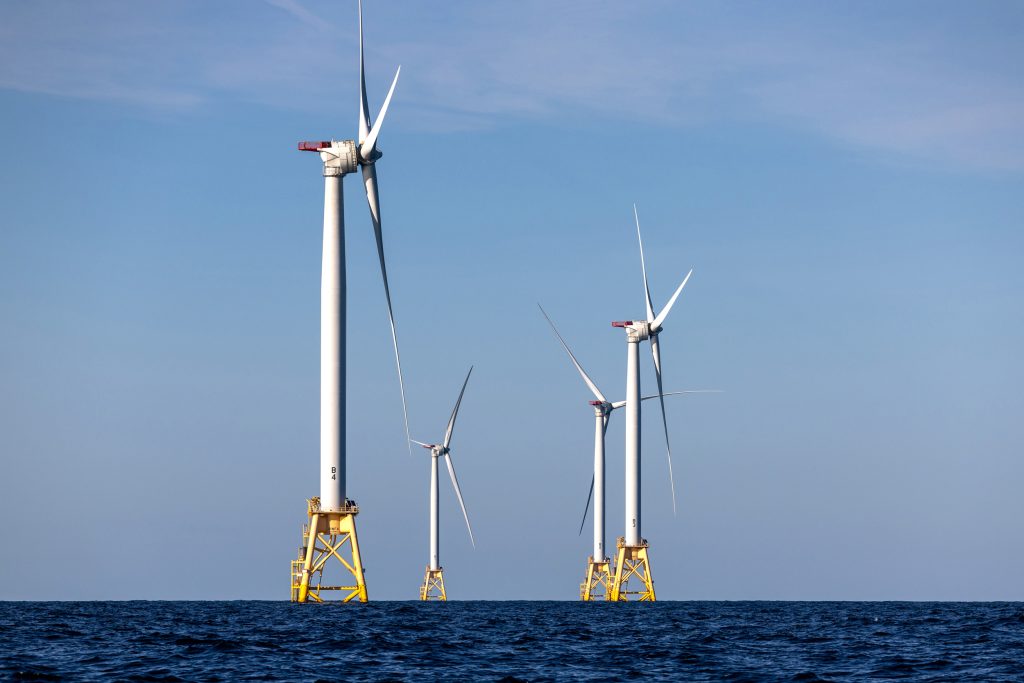The first and only U.S. multi-state agreement to buy offshore wind power is under strain after one of its members declined to participate in the recent selection of developers for three projects off the coast of New England.
The agreement between Massachusetts, Rhode Island and Connecticut seeks to attract developers by offering economies of scale while minimizing costs to each state. A memorandum of understanding between the states, announced in 2023, set a goal of building a total 6 gigawatts of offshore wind power, enough to power about 3.3 million homes, as part of the states’ plans to decarbonize their economies.
But Connecticut didn’t take a role in the selection of developers for about half of the power target when the procurements were announced in September, even though it has committed to increasing its use of offshore wind, and to cooperate with the other two states in attracting developers to its waters.
Will Healey, a spokesman for Connecticut’s Department of Energy & Environmental Protection, said the state is still considering its options for procuring offshore wind. He declined to say why it had not participated in the selection.
“The evaluation of project bids remains underway in Connecticut and we will announce a final decision in our solicitation at a future date,” Healey said in a statement. He called the agreement with the two other states “a pathway for a potential coordinated selection of offshore wind as each state solicited offshore wind energy generation through their respective state procurements.”
Offshore wind advocates said they were puzzled by Connecticut’s inaction, which raised questions about its commitment to an agreement that some analysts see as a potential template for other U.S. states seeking to add offshore wind to their power resources as cheaply as possible.
“Governor Lamont’s indecision on the offshore wind procurement is baffling,” said Charles Rothenberger, an environment and energy attorney for Save the Sound, an environmental nonprofit based in New Haven, Connecticut.
The state’s inaction is inconsistent with its offshore wind strategy, Rothenberger said. It has built a marshaling port for offshore wind farms at New London, and aims to use offshore wind as part of its goal for transitioning to 100 percent renewable power by 2040.
“Massachusetts and Rhode Island have demonstrated in the past that they are just as cost-conscious, if not more so, than Connecticut, yet they felt comfortable with the current proposals,” he said. “All three states share the same energy pressures. Yet Massachusetts and Rhode Island recognize that investing in offshore wind is the best way to address those pressures.”
The selection is the biggest order yet for offshore wind power from Massachusetts and the whole New England region, said Massachusetts Gov. Maura Healey. “The world will look to New England for the future of clean energy,” she said.
Rhode Island Gov. Dan McKee said the state is “taking a significant step forward in meeting our Act on Climate goals and building a clean energy economy. Together with Massachusetts, we are setting a precedent for regional collaboration in clean energy and advancing a sustainable, resilient future.”
The two states plan to buy a total of about 2.9 GW of offshore wind power, enough to power about 1.6 million homes, from South Coast Wind, New England Wind 1 and Vineyard Wind 2.
Massachusetts will take all but 200 megawatts of the total—which will be purchased by Rhode Island. The commitment represents almost 20 percent of Massachusetts’ total electricity demand, and is the state’s biggest offshore wind selection to date, a press release announcing the agreement noted.
South Coast Wind, formerly called Mayflower Wind, aims to generate almost 1.3 GW about 30 miles south of Martha’s Vineyard. The project is jointly operated by Shell New Energies U.S. and Ocean Winds North America, an international offshore wind developer.
New England Wind 1, operated by Avangrid Renewables, a subsidiary of Spain’s Iberdrola, plans to generate 791 MW, all of which is due to be purchased by Massachusetts under the new selection. The project is due to build a wind farm 23 miles south of Martha’s Vineyard.
Vineyard Wind 2, sited 29 miles south of Nantucket, is due to generate 1.2 GW, two-thirds of which will be taken by Massachusetts. Connecticut would potentially purchase the remainder. Vineyard Wind is jointly owned by Avangrid and Copenhagen Infrastructure Partners, a Danish investment firm.
Another two New England offshore wind projects are in planning, development or approval stages now, according to New England for Offshore Wind, a regional advocacy group representing environmental, trade union and consumer groups.
“The selection of a total 2,878 MW of offshore wind projects is a big win for Massachusetts and Rhode Island, and it demonstrates the benefits of a collaborative procurement approach for New England,” said Kelt Wilska, offshore wind director of the Environmental League of Massachusetts and the region lead of New England for Offshore Wind. “We urge Connecticut to take advantage of this moment and select bids to help realize the critical benefits that offshore wind will deliver for the people of Connecticut and the region.”


While Connecticut has yet to commit to procuring offshore wind under this agreement, the pact could become a national template for how to procure offshore wind and help meet decarbonization goals while controlling costs, said Kris Ohleth, director of the Special Initiative on Offshore Wind, a policy think tank that guides state and federal governments on how and whether to procure offshore wind.
She said the agreement isn’t yet a proven concept but Connecticut’s apparent decision to sit out the selection “somewhat defeats the purpose” of the initiative.
“With the higher amount of offshore wind that can be purchased across multiple states, there’s more opportunity to lower costs,” Ohleth said. “Connecticut certainly has the right to not accept any of the proposals. But even having a small part of the collective would have given strength to the concept, and more solace to the stakeholders that this was something that could work. It’s interesting that even 200 MW they couldn’t get behind if even Rhode Island could,” she said.
The need for interstate cooperation on offshore wind is likely to increase with the prospect of less support for the industry under the incoming Trump administration, she said.
“In Trump 2.0, states are going to need to find a variety of ways to band together,” Ohleth said. “States have always been the leader in offshore wind and all types of energy. They will continue to have creative solutions; they will work as interstate partners to strengthen their market share, coalitions and legal power as we face a likely very unfriendly White House to offshore wind in the next four years.”
But in another sign of growth for New England’s budding offshore wind industry, the Biden administration said on Oct. 29 that it sold leases to four wind energy areas in the Gulf of Maine, raising $21.9 million from two companies from leases that have the potential to power 2.3 million homes.
In Massachusetts and Rhode Island, the newly selected projects follow two others that are already under construction off their coasts.
Vineyard Wind 1, America’s first commercial-scale wind farm, began to transmit power from its site about 15 miles south of Martha’s Vineyard to the Massachusetts grid last winter. Federal authorities halted construction in July after a turbine blade broke and scattered into the ocean, leading to the closure of some local beaches. Construction resumed in August on some parts of the project, and in October, the company was given approval to restart installation of turbine blades. The project was initially scheduled for completion by the end of 2024.
Vineyard Wind 1 is due to consist of 62 turbines, generating a total of 806 MW, enough to power some 400,000 homes. It would create 3,600 full-time equivalent jobs, and save customers some $1.4 billion in electricity costs over its first 20 years of operation, the developers say.
Another New England offshore wind project, Revolution Wind, is currently under construction off the coasts of Rhode Island and Connecticut. It is due to generate 704 MW, 400 MW of which will be taken by Rhode Island, and the remainder by Connecticut.
The new commitment of states and developers to offshore wind projects in New England and elsewhere on the Atlantic coast follows recent disruption in the industry after some developers canceled projects or demanded renegotiation of contacts with states, arguing that the projects had become unworkable because of rising inflation, higher interest rates and supply-chain problems.
The cancellations included the former Park City Wind, now renamed New England Wind 1, which was recently re-selected by Massachusetts and Rhode Island, and is now renegotiating terms, according to New England for Offshore Wind. Commonwealth Wind, another canceled project, was renamed New England Wind 2, but was not selected in the latest state initiative.
While the terms of new contracts have not been publicly disclosed, they are expected to result in a higher price for power being awarded to developers, said Jennifer Delony, a spokeswoman for New England for Offshore Wind.
“While we do not know at what price the selected projects were bid for the tri-state solicitation, advocates generally accept that the per-MWh prices will be higher than the original contracts,” she said.
About This Story
Perhaps you noticed: This story, like all the news we publish, is free to read. That’s because Inside Climate News is a 501c3 nonprofit organization. We do not charge a subscription fee, lock our news behind a paywall, or clutter our website with ads. We make our news on climate and the environment freely available to you and anyone who wants it.
That’s not all. We also share our news for free with scores of other media organizations around the country. Many of them can’t afford to do environmental journalism of their own. We’ve built bureaus from coast to coast to report local stories, collaborate with local newsrooms and co-publish articles so that this vital work is shared as widely as possible.
Two of us launched ICN in 2007. Six years later we earned a Pulitzer Prize for National Reporting, and now we run the oldest and largest dedicated climate newsroom in the nation. We tell the story in all its complexity. We hold polluters accountable. We expose environmental injustice. We debunk misinformation. We scrutinize solutions and inspire action.
Donations from readers like you fund every aspect of what we do. If you don’t already, will you support our ongoing work, our reporting on the biggest crisis facing our planet, and help us reach even more readers in more places?
Please take a moment to make a tax-deductible donation. Every one of them makes a difference.
Thank you,


